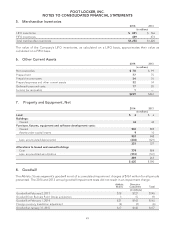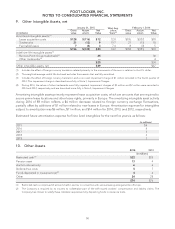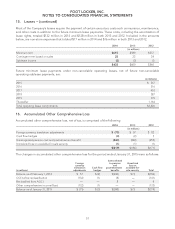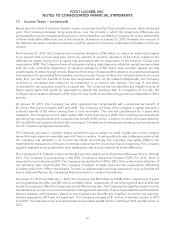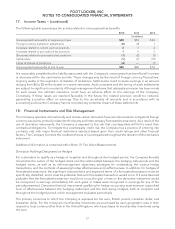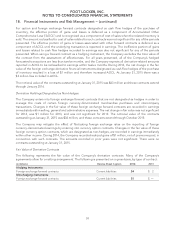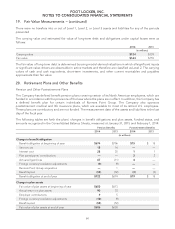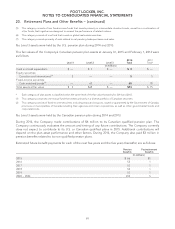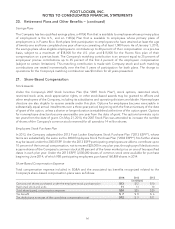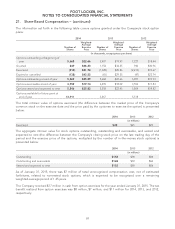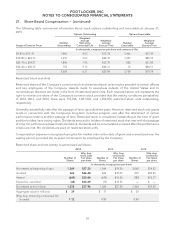Foot Locker 2014 Annual Report Download - page 82
Download and view the complete annual report
Please find page 82 of the 2014 Foot Locker annual report below. You can navigate through the pages in the report by either clicking on the pages listed below, or by using the keyword search tool below to find specific information within the annual report.
FOOT LOCKER, INC.
NOTES TO CONSOLIDATED FINANCIAL STATEMENTS
18. Financial Instruments and Risk Management − (continued)
Notional Values and Foreign Currency Exchange Rates
The table below presents the notional amounts for all outstanding derivatives and the weighted-average
exchange rates of foreign exchange forward contracts at January 31, 2015: Contract Value
(U.S. in millions) Weighted-Average
Exchange Rate
Inventory
Buy €/Sell British £ $63 .7996
Intercompany
Buy €/Sell British £ $32 .7640
Buy US/Sell CAD $ 2 1.1912
Business Risk
The retailing business is highly competitive. Price, quality, selection of merchandise, reputation, store location,
advertising, and customer service are important competitive factors in the Company’s business. The Company
operates in 23 countries and purchased approximately 89 percent of its merchandise in 2014 from its top 5
suppliers. In 2014, the Company purchased approximately 73 percent of its athletic merchandise from one
major supplier, Nike, Inc. (‘‘Nike’’), and approximately 11 percent from another major supplier. Each of our
operating divisions is highly dependent on Nike; they individually purchased 47 to 84 percent of their
merchandise from Nike.
Included in the Company’s Consolidated Balance Sheet at January 31, 2015, are the net assets of the Company’s
European operations, which total $883 million and are located in 19 countries, 11 of which have adopted the
euro as their functional currency.
19. Fair Value Measurements
The following table provides a summary of the recognized assets and liabilities that are measured at fair value
on a recurring basis: As of January 31, 2015 As of February 1, 2014
(in millions)
Level 1 Level 2 Level 3 Level 1 Level 2 Level 3
Assets
Available-for-sale securities $— $6 $— $— $6 $—
Short-term investments —— — —9 —
Total Assets $— $6 $— $— $15 $—
Liabilities
Foreign exchange forward contracts —5 ——2 —
Total Liabilities $— $5 $— $— $2 $—
Available-for-sale securities are recorded at fair value with unrealized gains and losses reported, net of tax, in
other comprehensive income, unless unrealized losses are determined to be other than temporary. The fair
value of the auction rate security is determined by using quoted prices for similar instruments in active markets
and accordingly is classified as a Level 2 instrument.
The Company’s short-term investments matured during the second quarter of 2014. In the prior periods
presented, these investments represented corporate bonds with maturity dates within one year of the purchase
date. These securities were valued using model-derived valuations in which all significant inputs or significant
value-drivers were observable in active markets and therefore are classified as Level 2 instruments.
The Company’s derivative financial instruments are valued using market-based inputs to valuation models.
These valuation models require a variety of inputs, including contractual terms, market prices, yield curves, and
measures of volatility and therefore are classified as Level 2 instruments.
59


